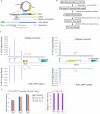Unraveling the influences of sequence and position on yeast uORF activity using massively parallel reporter systems and machine learning
- PMID: 37227054
- PMCID: PMC10259493
- DOI: 10.7554/eLife.69611
Unraveling the influences of sequence and position on yeast uORF activity using massively parallel reporter systems and machine learning
Abstract
Upstream open-reading frames (uORFs) are potent cis-acting regulators of mRNA translation and nonsense-mediated decay (NMD). While both AUG- and non-AUG initiated uORFs are ubiquitous in ribosome profiling studies, few uORFs have been experimentally tested. Consequently, the relative influences of sequence, structural, and positional features on uORF activity have not been determined. We quantified thousands of yeast uORFs using massively parallel reporter assays in wildtype and ∆upf1 yeast. While nearly all AUG uORFs were robust repressors, most non-AUG uORFs had relatively weak impacts on expression. Machine learning regression modeling revealed that both uORF sequences and locations within transcript leaders predict their effect on gene expression. Indeed, alternative transcription start sites highly influenced uORF activity. These results define the scope of natural uORF activity, identify features associated with translational repression and NMD, and suggest that the locations of uORFs in transcript leaders are nearly as predictive as uORF sequences.
Keywords: S. cerevisiae; genetics; genomics; mRNA Translation; nonsense-mediated decay; uORF.
© 2023, May et al.
Conflict of interest statement
GM, CA, MA, JM, JW, JM No competing interests declared
Figures















Update of
- doi: 10.1101/2021.04.16.440232
References
MeSH terms
Substances
Grants and funding
LinkOut - more resources
Full Text Sources
Other Literature Sources
Research Materials

